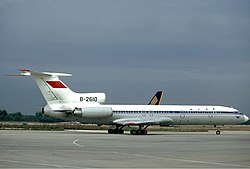Aircraft
The aircraft was a Tupolev Tu-154M (registration B-2610, factory 86A740, serial no. 0740). It was manufactured by the Kuibyshev Aviation Plant (KuAPO) on 22 December 1986 and was delivered to the Civil Aviation Administration of China (CAAC) few weeks later. In July 1988, due to reorganization, CAAC transferred the aircraft to China Northwest Airlines. The aircraft was powered with three Soloviev D-30KU-154-II low-bypass turbofan engines from the Rybinsk Engine Plant. On the day of the accident, the aircraft had 12,507 flying hours and 6,651 takeoff and landing cycles. [6]
Accident
The aircraft took off from Xi'an Xianyang International Airport at 8:13 on June 6, 1994. At the time, it was raining, but this did not cause a delay in departure.
Twenty-four seconds after take-off, the crew reported that the aircraft was "floating" and making an abnormal sound, but were still able to maintain a speed of 400 km/h (220 kn; 250 mph). [8] Three minutes after take-off, the plane flew over Xi'an City and turned southeast. [9] The crew then reported an unstable pitch-up to 20° and 30° at 8:16:24 and 8:16:58, respectively.
At 8:17:06, while over Mingdu Township, Chang'an County, Shaanxi, the aircraft became unable to maintain its assigned altitude. The crew then temporarily engaged the autopilot, which unexpectedly caused the aircraft to turn right. At 8:22:27, with the aircraft travelling at 373 kilometres per hour (232 mph), the stall warning activated. The aircraft then banked dangerously to the left, and dropped from 4,717 metres (15,476 ft) to 2,884 metres (9,462 ft) in 12 seconds, at a speed of 747 km/h (403 kn; 464 mph).
At 8:22:42, the aircraft disintegrated in mid-air above the suburb of Tsuitou Village, Mingyu Township. [10] All 146 passengers and 14 crew died, most on impact. [11] Wreckage landed to the southeast of the airport, scattered over 18 miles (29 km) of farmland.
This page is based on this
Wikipedia article Text is available under the
CC BY-SA 4.0 license; additional terms may apply.
Images, videos and audio are available under their respective licenses.

